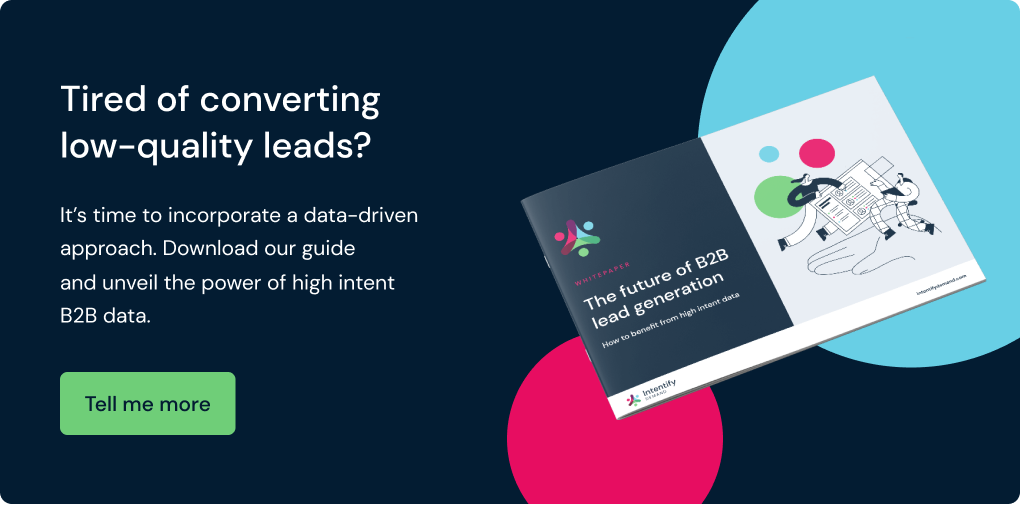Read time: 5 minutes
Everywhere you look, B2B businesses are talking about intent data, and most of them have high praise for the insights gleaned from intent signals. And it's true; high-intent data is gold dust for marketers. Why? Because it gives you an insight into a web visitor's purchase intent, allowing you to identify when a prospect is actively considering buying from you.
An impressive 99% of large companies agree that intent data has helped their business. That's by either improving marketing ROI or sales growth.
Therefore, understanding the purchase intent of individuals can make a big improvement to your bottom line, enabling you to close more deals and deliver exactly what your potential customers are looking for. It's all about tailoring your messaging at exactly the right time, and getting in front of potential customers before they make a decision. And while intent data doesn't provide a magic crystal ball, when combined with predictive analytics, it comes pretty close.
What are high-intent leads?
High-intent leads are potential customers who are showing strong signs that they're ready to make a purchase decision.
This goes beyond someone who's engaged with your top of the funnel content but is a qualified lead who is engaging with your brand, interested in lower funnel content and has the necessary decision-making power. This makes them more valuable than general leads as it means they're most likely ready for a conversation with your sales team (or will be soon!)
Recommended reading: Purchase intent: How to find best-fit lead opportunities
What's even better is generating high intent leads is great for boosting your return on marketing investment by:
- lowering customer acquisition costs
- shortening the sales cycle
- and increasing order value.
Sounds good, right? Almost too good to be true. So let's look at each of those areas in more detail.
Reducing customer acquisition costs
A high-intent lead is significantly likely to buy. This person fits your ideal customer profile (ICP) and their online activity indicates that they want to engage with a company like yours.
But how do they reduce acquisition costs?
Instead of waiting for leads to find you, and hoping they have the right kind of buying power, or that they're eventually going to be in-market for a solution like yours, focusing on high intent leads allows you to cut to the chase.
The first step is to ensure you have an accurate and up-to-date ideal customer profile (ICP). Look back at your previous, most high-value customers and identify common characteristics. Once you know what your ICP looks like, use intent data to identify and reach out to new prospects who fit the same profile and exhibit the same behaviours.
Recommended reading: How to build an ideal customer profile for better lead generation results
These are the prospects to focus your marketing efforts on. Spend time and money on campaigns that attract and nurture high quality leads with the most buying intent. As a result, you'll reduce your acquisition costs and increase marketing ROI.
Shorten the sales cycle
You can build relationships quickly by tailoring your marketing content to the real-time requirements of individual accounts and users.
This marketing strategy involves monitoring trends so you can identify behaviours that signal intent. These might include lingering on particular pages or downloading key resources.
This type of high intent data allows you to respond with helpful, timely and relevant content which in turn moves people through your pipeline and provides a more personalised experience that builds trust.
For example, cloud computing company Citrix combined intent data with technographic information about a company's tech stack to see if they could improve their lead conversion rate.
"We found leads were 2.5 times more likely to move to sales qualified lead and significantly more likely to turn into closed revenue. We’d actually closed deals from over a quarter of the marketing leads within three months – half the usual sales cycle." - Mathias Buettner, marketing director for Central Europe at Citrix
Identify cross-sell and upsell opportunities
Having better insight into how your high-intent leads are behaving and what they're interacting with will highlight opportunities to cross or upsell.
For example, if they begin to research a new product in your space, or consider an upgrade, you know they're open to starting a conversation with your sales team. Or you can provide tailored marketing content that answers the questions they're asking.
Recommended reading: 7 simple ways you can use intent data in your marketing campaigns this year
By nurturing the curiosity and intent they are already displaying, you can proactively guide them in their decision-making process, showing them that you understand their ever-changing needs which not only improves your conversion rate but also boosts your customer retention, average order value (AOV) and your marketing ROI.
Help potential buyers make important decisions
Your role is to move potential buyers through the marketing funnel. It's easy to forget that making a purchase decision can be a lengthy, daunting and complex task. It often involves multiple stakeholders as well as getting budget approved, and then implementation teams in place to roll it out or change current systems.
B2B buyers spend a full working week researching large purchases and the volume of information can be overwhelming.
Instead of clamouring for their attention, focus on being the helping hand that cuts through the noise. High-intent data helps you craft your marketing messages, address key pain points with relevant content and ensure that any communication is timely, and tailored while actively supporting potential clients in making a decision. Not only does this create a smoother buyer journey, but it also means your sales team can be more confident when speaking to high quality leads, knowing the purchase intent is there.
This article was updated 7th March 2024




